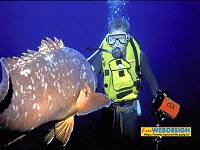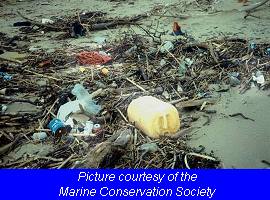
|
The world of non-commercial film and A-V |
Events Diary | Search | ||
| The Film and Video Institute | | ||||
Hints and Tips
 As with taking stills, fish are particularly difficult to get
good shots of, as they tend to swim away as soon as you point the camera
at them. Shots of an animal's backside disappearing into the haze don't win
any prizes. Territorial fish such as eels, blennies, cuckoo wrasse or any
fish guarding eggs make good subjects. The golden rule is to let your subject
swim into the frame, do something, then swim out of the frame.
As with taking stills, fish are particularly difficult to get
good shots of, as they tend to swim away as soon as you point the camera
at them. Shots of an animal's backside disappearing into the haze don't win
any prizes. Territorial fish such as eels, blennies, cuckoo wrasse or any
fish guarding eggs make good subjects. The golden rule is to let your subject
swim into the frame, do something, then swim out of the frame.
Unfortunately, fish don't read rule-books any more than they do scripts, but the bit about letting your subject leave the frame is fairly easy to achieve.
Another tip: unless the conditions are incredibly clear, don't use the camera on autofocus, as it will keep trying to focus on bits in the water and will move in and out of focus, which is an annoying effect called "hunting". Manually focusing takes a little longer but will give you much better results.
 One final thought on shooting is that your camera can be a tool
for education. Don't just film the pretty things - shots of rubbish on the
seabed, damaged reefs or pollution are a graphic reminder of what damage
is being done to the marine environment and, shown to the right people, can
reinforce the work of conservation organisations.
One final thought on shooting is that your camera can be a tool
for education. Don't just film the pretty things - shots of rubbish on the
seabed, damaged reefs or pollution are a graphic reminder of what damage
is being done to the marine environment and, shown to the right people, can
reinforce the work of conservation organisations.
Keep up to date with your filming by logging all your tapes, including date, location, subject and time codes. That way, when you need those award-winning shots of great whites mating, you'll know just where to find them.
There's a whole array of digital editing software you can buy for a PC or laptop. With this you can input images straight from your camera and manipulate them to your heart's content, adding graphics, music and titles.
If you don't have these facilities, try your local TV station. It will have edit suites with editors you can hire by the hour, but it is expensive. Alternatively, if you have interesting footage from your local area, they might like to use it as a news item in return for doing the editing.
When it comes to writing the script for the narration, there are a few golden rules. Number one: don't describe what the viewers can see plainly for themselves.
Don't say: "The bright purple and green wrasse swims backwards and forwards collecting weed for the nest" because the viewer knows that. Instead go for something which is not obvious but still relevant: "The male wrasse, sporting his breeding colours, takes more than two weeks to build the nest."
There's no need to go overboard with facts and figures, just choose the most interesting points. The narration should cover only about one third of the film. Where it's obvious what's happening, let the pictures do the talking.
![]()
Share your passions.

Share your stories.